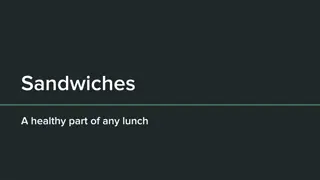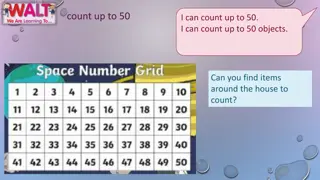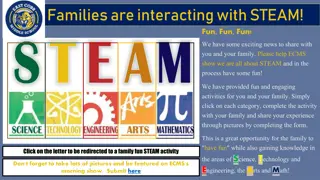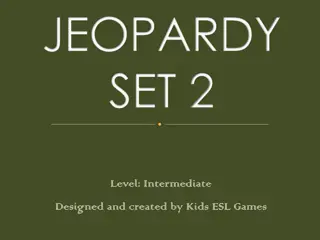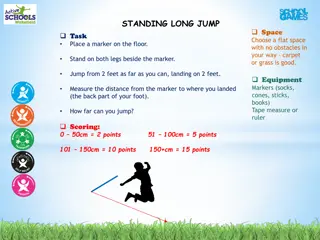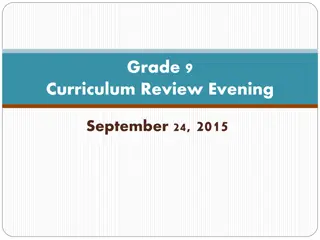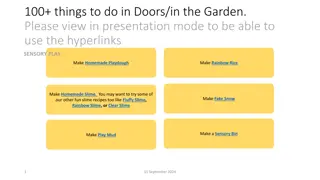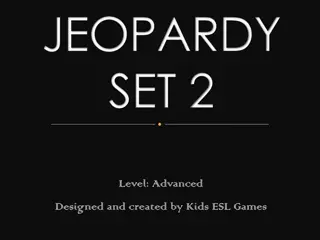Fun Lunchtime Activities for Kids
Engage children with exciting lunchtime activities like Foursquare and Spud, offering rules and guidelines for each game. These games are suitable for both Key Stage 1 and 2 students, providing a mix of physical activity and fun interactions during break times.
Download Presentation

Please find below an Image/Link to download the presentation.
The content on the website is provided AS IS for your information and personal use only. It may not be sold, licensed, or shared on other websites without obtaining consent from the author.If you encounter any issues during the download, it is possible that the publisher has removed the file from their server.
You are allowed to download the files provided on this website for personal or commercial use, subject to the condition that they are used lawfully. All files are the property of their respective owners.
The content on the website is provided AS IS for your information and personal use only. It may not be sold, licensed, or shared on other websites without obtaining consent from the author.
E N D
Presentation Transcript
Lunchtime Activities Lunchtime Activities
Lunchtime Activities Lunchtime Activities All of the games that follow can be used in both KS1 and KS2. The rules are set out as the game should be played but feel free to develop and adapt them to suit your schools needs, space, time, equipment and children's abilities.
FOURSQUARE FOURSQUARE GAME RULES: Server (King) Server Must Ask Are you Ready before serving Everyone must Hit UNDERHAND Just to Clarify You are out if The ball in your square bounces 2 times or you hit it before it bounces You hit the ball out of bounds You hit the ball to an inside line You hit the ball Overhand You hit a ball that was another players ball (it bounced in their square and you hit it before it bounced a 2nd time) A ball bounces in your square an you are unable to get to it before it bounces a second time Ball must bounce ONCE and only ONCE in your square before your strike it (including on the serve) If someone makes a mistake you rotate up and that person goes to the back of the line (outside the #1 square) Server takes care of any arguments (unless it involves the server then vote as a group, or play rock paper scissors) You can move anywhere outside the square or in your section of the square If it bounces in your square you MUST strike it No Carrying, Stalling or Holding you must Strike or Hit the ball
SPUD SPUD GAME RULES: Group of 6-8 children, cone off a medium/large area. Children make a circle and one child stands in the middle holding a soft ball. Child in the middle throws the ball in the air, when they do the other children can run away but stay in the area. When the child who threw the ball up catches the ball they shout SPUD all the children running away must freeze. The child with the ball must then throw the ball and try and hit one of the children who were running away. If children are too far away for the thrower to reach them, introduce a 3 step rule where the thrower can take up to 3 steps to get closer to a runner. If a runner gets hit they get the letter S and now become the thrower and the game restarts from the original circle. if the thrower misses they get the letter S and remain as the thrower but the game restarts from the circle. If a Child loses all their lives and collects the word SPUD they are out.
Fruit Salad Fruit Salad Game Rules: Children sit in a circle, then name each child a piece of fruit (Apple, Pear, Banana, Orange) only use 3 or 4 different fruits. One child stands in the middle and shouts out the name of one of the fruits. Then all of the children with that name jump up and have to find a different place in the circle. The child in the middle also has to find a free place. There should always be one child who misses out on a place so they go in the middle and shout the next fruit. You can use names of anything, i.e animals, football teams, Disney characters etc.
Noughts and Crosses Noughts and Crosses Game Rules: Set out a grid of spots or hoops 3x3 Split group into two teams of 3, each group needs 5 cones of the same colour but different colour for each team. The teams are placed a distance of at least 5 metres away from the grid. On go the first person from each team runs and places one cone on one of the spots, run back to their team and the next person goes. The winning team is the one who gets 3 coloured cones in a line first. You can add a referee to each game who can then swap with one of the members of the losing team after each game.
Dont Feed The Animals Don t Feed The Animals Game Rules: Set up the game as shown in the diagram opposite. Visitors don t have to use footballs they can carry any ball or object. Animals can t leave the inner circle (cage) Visitors must try and get past the Zookeeper s without being tagged and pass the object to the animal (feed the animals) The visitor then becomes an animal and the animal then becomes a visitor and takes the object to the outside of the outer circle.. If the visitor gets tagged, then they move back to the outside and try again. Change Zoo Keepers every couple of minutes.
Protect The Tower Protect The Tower Thrower Game Rules: Children play in an open space and form a circle around the Tower (Cricket stumps, box, bin, an object that is tall and of reasonable size). One player is designated as the protector of the Tower and is allowed to touch the ball with their hands or body but not the feet. Children (throwers/rollers) may retrieve the ball from inside the circle area but have to go back to the perimeter of the circle to throw/roll. After each successful hit of the target, the guard is rotated (the person who hits the target guards the bin next) Protector
Protect The Tower Teams Protect The Tower Teams Game Rules: Play the game on a dodgeball style court with one team on each side. Set out 4-5 towers (witches hat cones, Cricket stumps etc) on each side and place a hula hoop over the top to prevent close guarding. The aim is for the opposite team to try and knock down the other teams tower by rolling balls at it. No throwing/kicking allowed. Winning team is the one who knocks all of the oppositions towers down first.
Time Out Time Out Game Rules One person has control of a stopwatch. Any others who wish to play stand by the controller who calls out a time (e.g. 20 seconds .) The controller calls Go as he/she starts the stopwatch. Everyone jogs or runs around and returns to stand by the controller when they think 20 seconds is up. The person who returns closest to the time is in charge of the stopwatch next time. Adapt the time and exercises to suit the group.
Dragons Treasure Dragons Treasure Game Rules Pick one person to be the dragon and they stand in a hoop (Dragons lair) Spread cones (treasure) around near the dragon. The Knights (rest of the competitors) stand in a line around 10m away from the dragon. The dragon must turn around with their back to the knights. Then the knights can try and move forwards towards the treasure. If the dragon turns around the knights must be still. if the dragon see s anybody moving they must go back to the start. If a knight reaches the treasure, they can take one piece and run back to the start and repeat the process. First knight to get 3 pieces of treasure is the new dragon.
Cat & Mouse Cat & Mouse Game Rules One person is selected as a cat and one as a mouse. The rest of the children form a circle spaced out enough so each child can hold their arms out to the side. The mouse is on the outside of the circle and the cat is on the inside. The rest of the children are the house. You call out house open or house closed if the house is closed, children hold their arms up to close the circle, if the house is open the children place arms by their sides so there are gaps to get in and out of the circle. The aim for the cat is to try and catch the mouse (tig). The aim for the mouse is to try and enter the house and escape without being tagged. You can control how long the house is open and closed for. The cat can leave the house to try and catch the mouse if they want to.
Elephant Football Elephant Football Game Rules Everyone stands in a circle, feet touching and legs wide apart, one hand behind the back. The aim of the game is to score a goal by hitting a soft ball through someone else s legs with the hand not behind the back (Elephants Trunk). You can only hit the ball with the flat of your hand. You can also stop the ball going through your legs with the flat of your hand. If a goal is scored the person who conceded starts the next go. Play for a length of time person with the most goals is the winner. Game works best with 6-8 players. If you have more set up 2 games at a time.
Clap Catch Clap Catch Game Rules Children stand in a circle. You stand in the middle with a soft ball. (size and type of ball can be changed to ability of group) You go around the group one person at a time saying clap or catch at the same time you throw them the ball. If you say clap, that person must clap their hands and then catch the ball. If you said catch then they just perform the catch. If a person fails to follow the instruction then they are out and sit down. If the person fails to catch the ball they are out. After you have gone around in a circle you can throw to people in random. The winner is the last person standing. To make it more challenging, make them do opposites so catch means clap and vice versa.
Hoop Ball Game Rules This game is played in pairs. Set out a hula hoop on the floor with two spots placed 3-5 metres either side of it. (this distance can be changed according to ability) Each pair has one ball, ideally basketball. The aim of the game is for the people in the pairs to take turns to try and throw the ball so that it bounces in the hoop (on the first bounce) if they successfully do that then they score a point. The first person to 3 or 5 points is the winner. If you have a lot of pairs playing then when the game is over the winner stays with the ball, the loser has to go and find another person to go and challenge.
Danish Rounders Danish Rounders Game Rules Four posts placed approximately 10 paces apart in a square. 2 teams one batting team, one fielding team. Or groups of 6 and take it in turns to bat bowl and field moving around the different bases and Bowler bowls the soft ball to the first batter who bats it with their hand (unless the game is supervised, and then a light plastic bat could be used and carried as the batter runs around the posts). After hitting the ball, the batter runs around all four posts without stopping and touches the fourth post to be in and score a rounder. In the meantime when the ball is hit, the fielders must collect the ball and pass the ball to posts 1, 2, 3, and 4 in order and try to beat the batter to the fourth post. This can be thrown or rolled. A batter is out if:- (1) The ball is passed round all 4 posts and beats him / her to 4th post. (2) The ball is caught directly from a hit. (3) A player intentionally hits the ball behind him / her.
Playground Challenges A series of challenges that can easily be performed and set up. These can be run as year group challenges or whole school challenges. Time each challenge for 30 seconds or 1 minute, or time how long it takes them to complete it or measure the distance and record the scores. You can create a lunchtime challenge display and place the winner's names up for one week and award a prize for example team points or dojo points. Challenges Basketball bounces Football dribble slalom Tennis keepy uppies Hockey slalom Javelin (object) throw Standing long jump Speed Bounce Tennis ball bounce and catch Create your own






